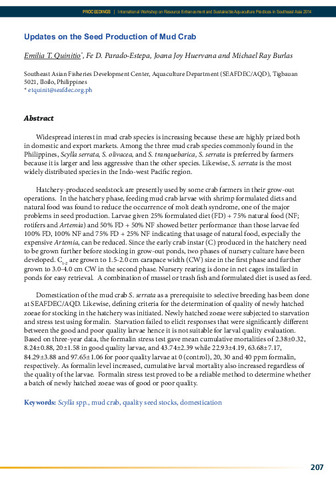Nursery culture of mud crab Scylla serrata fed diets supplemented with trytophan at two stocking densities
| dc.contributor.author | Alava, Veronica R. | |
| dc.contributor.author | Lucero, Marjorie Aijee | |
| dc.contributor.author | Sumile, Jony D. | |
| dc.contributor.author | Parado-Estepa, Fe D. | |
| dc.contributor.editor | Quinitio, Emilia T. | |
| dc.contributor.editor | Parado-Estepa, Fe Dolores | |
| dc.contributor.editor | Coloso, Relicardo M. | |
| dc.date.accessioned | 2017-08-25T09:01:40Z | |
| dc.date.accessioned | 2017-08-25T16:32:09Z | |
| dc.date.available | 2017-08-25T09:01:40Z | |
| dc.date.available | 2017-08-25T16:32:09Z | |
| dc.date.issued | 2017 | |
| dc.identifier.citation | Alava, V. R., Lucero, M. A., Sumile, J. D., & Parado-Estepa, F. D. (2017). Nursery culture of mud crab Scylla serrata fed diets supplemented with trytophan at two stocking densities. In E. T. Quinitio, F. D. Parado-Estepa, & R. M. Coloso (Eds.), Philippines : In the forefront of the mud crab industry development : proceedings of the 1st National Mud Crab Congress, 16-18 November 2015, Iloilo City, Philippines (p. 147). Tigbauan, Iloilo, Philippines: Aquaculture Department, Southeast Asian Fisheries Development Center. | en |
| dc.identifier.isbn | 9789719931072 | |
| dc.identifier.uri | http://hdl.handle.net/10862/3182 | |
| dc.description | Abstract only. | en |
| dc.description.abstract | Cannibalism has been recognized as one of the major problems in crab culture. The use of dietary tryptophan (TRP) that has been reported to reduce cannibalism in crabs under laboratory conditions was verified in pond nursery culture at two stocking densities. The first phase used hatchery-produced early crab instar. After 3-4 weeks, survivors were sorted and the small size crabs were further reared in the second phase. Crabs were stocked in 12-m2 net cages installed in brackishwater pond and fed three times daily at 0830, 1300 and 1630 h. The feeding scheme used was a combination of mussel meat (M) and formulated diet (FD) at 30:70 ratio. The original FD contained 45% crude protein (used in Experiment 1, 2 and 3) that was lowered to 40% crude protein in the new basal diet used in the succeeding experiment. The two TRP-supplemented diets had 0.5% and 0.7% TRP levels. Results showed that the TRP-supplemented feeds did not give consistent results in terms of growth and feed conversion ratio, indicating that the original basal diet (0.4% TRP and 45% crude protein) or the new basal diet (0.4% TRP and 40% crude protein) were sufficient to be used together with mussel meat as feed for crab juveniles. Higher survival rates were obtained at 50 m-2 (phase 1) and 10 m-2 (phase 2) than at 30 m-2 and 5 m-2 stocking density, respectively. All trial runs produced positive returns on investment. | en |
| dc.language.iso | en | en |
| dc.publisher | Aquaculture Department, Southeast Asian Fisheries Development Center | en |
| dc.subject | Scylla serrata | en |
| dc.subject | Philippines | en |
| dc.title | Nursery culture of mud crab Scylla serrata fed diets supplemented with trytophan at two stocking densities | en |
| dc.type | Conference paper | en |
| dc.citation.spage | 147 | |
| dc.citation.conferenceTitle | Philippines : In the forefront of the mud crab industry development : proceedings of the 1st National Mud Crab Congress, 16-18 November 2015, Iloilo City, Philippines | en |
| dc.subject.asfa | brackishwater aquaculture | en |
| dc.subject.asfa | cage culture | en |
| dc.subject.asfa | cannibalism | en |
| dc.subject.asfa | crab culture | en |
| dc.subject.asfa | diet | en |
| dc.subject.asfa | feeds | en |
| dc.subject.asfa | feed efficiency | en |
| dc.subject.asfa | feeding experiments | en |
| dc.subject.asfa | marine crustaceans | en |
| dc.subject.asfa | pond culture | en |
| dc.subject.asfa | stocking density | en |
| dc.subject.asfa | survival | en |
| dc.subject.scientificName | Scylla serrata | en |
このアイテムのファイル
このアイテムは次のコレクションに所属しています
-
Philippines : In the forefront of the mud crab industry development [44]
Proceedings of the 1st National Mud Crab Congress






